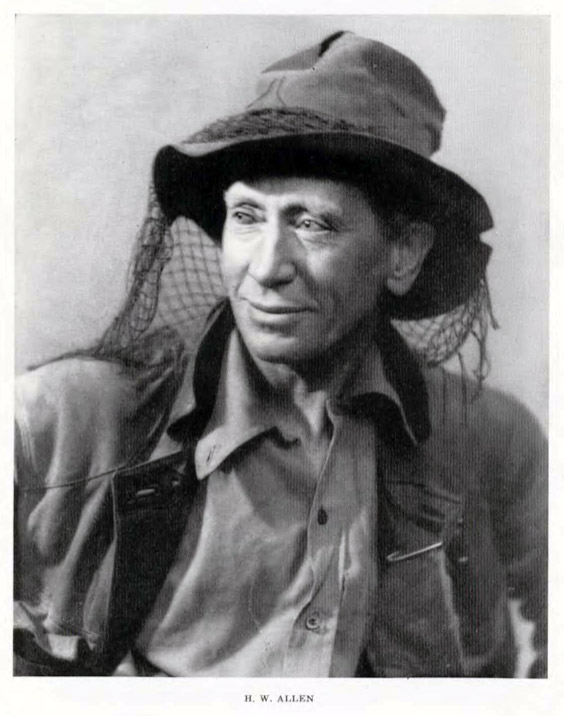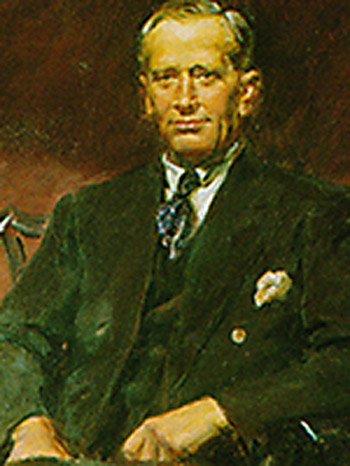


[1] 1910s, courtesy Melbourne University. [2] Portrait at Haileybury College, undated. [3] Presenting the "blues" to selected athletes at Wilson Hall, Melbourne University, 1929.
CAREER SUMMARY
Birth
January 31st 1875
Maryborough Vic Australia
Death
August 13th 1949
Frankston Vic Australia
Clubs
National Ice Skating Association of Australia, Melbourne University Sports Association, Melbourne University Ski Club
Skating Championships
Nil
Figure Skating Judge
President, NISAA (Victoria)
Vice-president, Melbourne University Sports Association
President, University Ski Club
BORN JANUARY 31st 1875 at Maryborough, Victoria, Allen was the eldest son of Rev William Allen and his teacher wife Martha Jane (Holdsworth). His father, who attended Scotch College, trained at the Congregational College of Victoria during the years that Rev John Reid, father of H Newman Reid, lectured there in theology and philosophy. H Newman Reid founded Australian ice sports at Melbourne Glaciarium in the early 1900s.
Allen attended Scotch, too, but he was also the first student to enroll at Haileybury College in its foundation year of 1892. He was the top student in Victoria in Greek and Latin that year, described by headmaster Charles Rendall as "the most brilliant pupil I ever had". [1] In 1893, he gained outstanding results at the University of Melbourne where he took honours in classics with Thomas George Tucker, and graduated in Arts (BA 1896) which he followed with a Masters degree (MA 1898).
Allen became a teacher and vice-master of the Presbyterian Ormond College at the University of Melbourne, [190] but he was much more than an academic due to a range of sporting interests. He played cricket, football and tennis. He was an excellent billiards player, an expert fly fisherman, and an outstanding ice skater at Melbourne Glaciarium. These interests led to vice-presidency of the Melbourne University Sports Union (now Melbourne University Sports Association), where his duties included presenting University Blues. [191] On ANZAC Day 1917, he enlisted at 42 and served overseas in the AIF Education Unit where he achieved the rank of captain.
After the war Allen became president of the National Ice Skating Association of Australia (NISAA) where [145] according to the Master of Ormond, David Picken, he "ranked as one of the Australian judges who could have gone to Scandinavia as a 1934 World Championship judge". [467] Australia joined the International Skating Union in the early 30s, but another thirteen years went by before the nation produced its first ISU judge.
Allen presided over the organisation and development of the early instruction programs, proficiency standards and championship competitions at the Glaciarium, guiding the ice skating school towards preeminence in Australia and New Zealand. While the Sydney club conducted their own figure skating championships independently of Melbourne for twenty years, Allen's administrative contribution as NISAA president and vice-president of the University Ski Club, spanned the foundation and consolidation of both ice and snow sports in Victoria, in addition to the balance of the other eighteen sports at the University.
Vice-master under David Picken from 1915 until his retirement in 1944, Allen is remembered as an inspiring and lively teacher, whose wit was delightful and never palled. [190] He only attended Haileybury for one year, but he helped create the Old Haileyburians Association, served as president six times over 39 years, and displayed a lifelong interest in the school and its students. A thoroughbred horse bearing Allen's name ran around the racing tracks of Victoria for many years thanks to an OHA initiative. [1]
Allen's brothers were Leslie, lecturer in Latin and English at Canberra University College, and Sir Carleton Kemp Allen, Professor of Jurisprudence at Oxford and Warden of Rhodes House, who awarded many Rhodes Scholarships to North Americans.
Allen died unmarried at 74 on August 13th 1949 at Frankston in Victoria. [190] His place among the leaders of Victoria's earliest secondary and tertiary schools helped the flow of new enthusiasts and athletes to Victorian winter sports. Hugh Collins, a successor as Master of Ormond College, said despite Allen's brilliance and versatility "he chose a life that many would consider solitary, unselfish and unambitious".
Scotch College, now the oldest surviving secondary school in Victoria, was first established in 1851, the year before Allen's father arrived in Australia at the age of four. The founder, Rev James Forbes, the first settled minister of the Presbyterian Church in Victoria, had opened it in a small house in Spring Street in central Melbourne, under the name of the Melbourne Academy. From the time of his appointment in 1857, Alexander Morrison (1829-1903), the second headmaster, wanted to change the pervasive classicism of colonial secondary schools, and he set about making Scotch in the image of Scotland's Elgin Academy, where he had been both student and teacher. This was consistent with the desires of the townspeople of Melbourne, and Scotch became the largest church school in Australia under his reforms and leadership, remaining so for 35 years until the 1890s depression.
By 1875, the year Barney Allen was born, a visit to Britain had convinced Morrison that Victorian schools were as well adapted to the times as English grammar schools. He then initiated Ormond College at the University of Melbourne. Still today, Who's Who in Australia lists Scotch College alumni more often than those of any other school, followed by three other Victorian schools; Melbourne Grammar, Melbourne High, and Geelong Grammar. Allen succeeded Ernest Iliff Robson BA MA (1861-1946) as classics teacher at Ormond when Robson became headmaster of Sydney Church of England Grammar School. Some players in the New South Wales ice hockey association during the 1920s were educated there (see Henry Hinder). In 1895, Robson married Kate Isabel, daughter of Alexander Morrison, the headmaster of Scotch.
While John Grice was a product and patron of the Church of England tradition in Victorian education and sports, including Melbourne Girls Grammar, Allen represented the Congregational and Scots-Presbyterian tradition through Scotch College boys secondary school, and Ormond College at the university. Both men adhered to the religious and educational choices of their pioneering fathers and, oddly enough, it was these traditions that first connected them to ice sports.
Allen enlisted at the age of 42, on ANZAC Day 1917, starting in the Sportsman's Unit at Broadmeadows in Victoria. He was 5-foot 9-inches tall, weighed 147 pounds, with a 32 inch chest, blue eyes, fair complexion and hair. He embarked on the SS Ventura for overseas service with the 7th Battalion on December 19th, 1917. He transferred to the Australian Flying Corps in February 1918, and he was commissioned and posted to the AIF Education Service the following September. He was promoted Lieutenant on January 23rd, 1919, and Honorary Captain two weeks later. He returned to Australia on October 30th, 1919, where he was discharged in January 1920. A review of his talk to the Classical Association of Victoria ten months later, is held by the Australian War Memorial: H W Allen's Xenophon's Greek Diggers. [192] It compares the soldiers of the 1st AIF with their ancient Greek predecessors. He also compiled his university's Record of Active Service 1914-18 (1926).
Ross Carpenter, 'Allen, Barney (1875-1949)', Legends of Australian Ice, Melbourne, Australia, http://icelegendsaustralia.com/legends-2/bio-allen-b.html, accessed online .
Record of Active Service 1914-18, Melbourne University, H W Alllen, 1926
Xenophon's Greek Diggers, H W Alllen.
Cradle of a National Sport: H Newman Reid and Melbourne Glaciarium, Legends of Australian Ice, Ross Carpenter, Online
